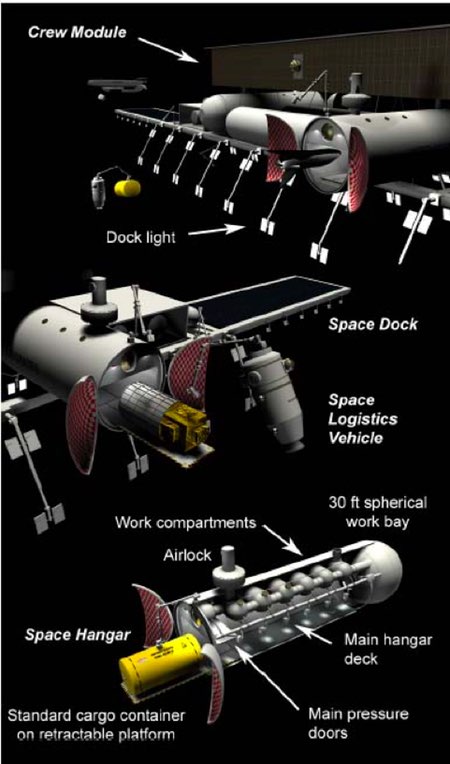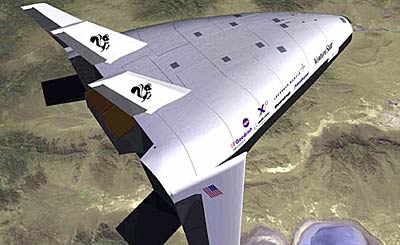Finally, a prudent space access architecture perspectiveby Steve Hoeser
|
| The challenge for RLV engineers is to avoid preconceived operational architectures. The fact is that fully reusable transports offer opportunities that neither the shuttle nor current mostly-expendable launchers could ever provide. |
This recent ULCATS Act proposes using a government cash prize to stimulate the development of fully-reusable launch vehicles (RLVs). Such transports can provide the kind of high flight rates and rapid turn-around times that yield cheap, safe, and reliable access to (and from) space that has been lacking. It correctly professes that such capabilities would be in the interest of US national security, civil space endeavors, and will allow US commercial RLV operators to establish the country as the undisputed world leader in space transportation. It is frankly one of the best-crafted systems-objective-based requirement sets I’ve seen since the ones put out by the Strategic Defense Initiative Office for their Single Stage To Orbit (SSTO) and the later successful Delta Clipper Experimental programs.
An item that specifically caught my eye was in the section on definitions. Item (4) states that for the winning vehicle, a “Minimum Required Orbit (MRO) shall be at least 400 kilometers altitude, circular, at 51.6 degrees inclination.” This appears to be a mission objective driven by servicing a NASA space station like the ISS. This should not be taken as a caving in to NASA pressure. Rather, it is a recognized market reality that both now and in the anticipated future, the International Space Station currently provides, and will likely continue to provide, a strong space transport market service demand. Seen in this context, it makes perfect business sense to leverage this NASA and international customer need.
However, the potential for misunderstanding the space transportation architectural implications of this MRO definition is a real possibility. In the space shuttle transportation operational architecture, for example, the entire shuttle flew to the space station. Current expendable launchers have turned back to the past and are including a capsule-based architecture with some “partly reusable” equipment. The challenge for RLV engineers is to avoid preconceived operational architectures. The fact is that fully reusable transports offer opportunities that neither the shuttle nor current mostly-expendable launchers could ever provide. To maintain such current culture design perspectives can easily lead to sub-optimal, highly costly, or even failed RLV system solutions.
When evaluating system solutions to create new transport networks, good transportation system architects will break the entire trip into transport segments. The segments are logically grouped based on the transport environmental conditions. The resulting transporter capabilities, features, and technologies are then selected to provide the most cost effective solution for that segment of the mission.
Launch transit environments require that RLV transport solutions be designed to fight their way out of Earth’s deep gravity well through brutal dynamic atmospheric pressures associated with the acceleration to orbital velocities. With the limits of the available energy imposed by the laws of nature using even the best chemical rocket engines, it is actually rather amazing that launch vehicles can obtain the velocities needed for a reasonably stable orbit. This, perhaps, is the key reason designing rocket launchers to work like disintegrating totem poles has been the norm till now. Now add the design challenges associated with adding the thermal protection equipment and subsystems needed for an RLV to transit back down through this same demanding environment to land for reuse, and you have a heady (but achievable) system design challenge. There is a reason, they say, rocket science is hard.
The reality is that the early promise of the reusability of the space shuttle was transformed from realizing its original job as a low cost cargo hauler into an oversized recreational vehicle. It is little wonder that, once built, the entire shuttle orbiter boosted into orbit and then maneuvered to dock with the space station to complete the facility’s assembly and conduct servicing missions. Its transmuted design gave us little choice to use it any other way.
| Engineers can make system architecture design decisions as they see fit to provide the best Earth orbit transport services at the revolutionizing operations costs so long envisioned. |
Unfortunately, once this shuttle-based space transport architecture was in place, it became “just the way things were done.” We continued to use it the same way for both cargo and passenger transport until its retirement. Such long-term operational architecture culture biases often create pre-assumed solutions when looking into future systems. Such pre-assumed architectures cause unintentional consequences when propagated into new launcher design programs. Such an imposed pre-assumed bias toward operations architectures was one key reason that the otherwise promising VentureStar SSTO RLV concept program failed.
Fortunately, the proposed bill’s section on general requirements puts the kibosh on such imprudent predisposed architecture design solution dictates. It does so by taking a step back and decoupling the transportation architecture operations from the ultimate transportation network system design solution. This is accomplished by stating that the real end game requirement is ultimately the:
transportation of a payload of at least 1 metric ton to the Minimum Required Orbit, using an RLV, where all or part of the RLV will complete at least one complete orbit of the Earth, and then return safely to the surface of the Earth. [Emphasis added]
What this architecture-independent perspective allows is the freedom for designers to apply the creative flexibility necessary to best meet the overall transport mission needs. They can make system architecture design decisions as they see fit to provide the best Earth orbit transport services at the revolutionizing operations costs so long envisioned.
This engineering freedom also allows for a balanced consideration of the engineering performance realities of chemical rockets for a given flight segment. These realities permit selection of the best chemical rocket engines, structures, and modern avionics combinations for an RLV flight segment coming up from the Earth to get “just barely” to orbit. Once there, they are in a sufficiently stable cargo transfer state where they can (and should) “stage” their cargo or conduct an in-space cargo transfer to an orbital “space tug” which has been designed for optimal payload transport in space.
Such transport network architectures have been developed and used effectively for years. They are called shipping ports and intermodal air-cargo transfer facilities, as illustrated below. A creative space transport network design team might even figure out a way to build a semi-reusable orbital transfer stage that’s used enough times to offset its purchase costs and initial Earth-to-orbit launch costs while still making a profit.
 Cargo Transport Intermodal Architectures Optimize Efficiency and Profitability. Credits: Gama Intermodal, Hannes Grobe-Creative Commons, Inbound Logistics, Distribution Management, Davin Raj Saroj, Atlas Dunnage |
An example of such an orbital intermodal facility has been postulated by my associate Dr. Mike Snead. The Space Logistics Base, illustrated below, is a notional concept consisting of twin opposite-facing space hangars, with an upper crew module and a lower space dock. In the top of the illustration, a Space Launch Vehicle (SLV) tug is maneuvering a cargo module off-loaded earlier. A small reusable lifting body passenger upper stage is entering the nearest hangar in the same top picture. In the center illustration, an SLV tug positions a satellite at the entrance to the space hangar. The bottom illustration shows a cut-away view of the space hangar where servicing and even construction can occur. An animated emplacement sequence of this orbital intermodal facility is also available.
 Notional Space Logistics Base. Credit: James Michael Snead, PE as published in Air & Space Power Journal, August 31, 2005. |
It is time to realize that RLV designs need to be driven by the demands of each segment of the total space transportation network architecture. In other words, the key is to design, then to focus on the job of getting the RLV vehicles and their payloads through the air-space transit environments just far enough out of the gravity well to one of prudently-placed orbital intermodals. Once in such a reasonably stable, energy-edge-point orbit, they can take the time to make their payload, passenger, or cargo “intermodal” transfer or drop off their payload to be moved by more effective in-space transporters.
| Ultimately, the purpose of an RLV is to go to and from space at the lowest cost in a safe and reliable fashion while still making money. |
Dragging around all thermal protection, related subsystems, and structural mass needed by an RLV to transit to and from Earth to then maneuver around in orbit is engineering foolishness. When engineers are empowered to exploit space transportation architecture flexibility, they will joyously create exceedingly elegant RLV solutions. Combined with optimized space tugs, cargo handlers and passenger transfer stages extremely cost effective space vacuum payload transit operations networks will occur.
Ultimately, the purpose of an RLV is to go to and from space at the lowest cost in a safe and reliable fashion while still making money. What was forgotten (especially on programs like the X-33) is that the bottom line must be to let innovative design and market forces drive space transportation network solutions enabled by RLVs. This means leaving the in-space part of the trip to real space ships.
The proposed Ultra-Low Cost Access to Space Act of 2016 finally presents a prudent RLV technology development strategy. It gives strong hope that, perhaps, there is finally a chance to change outdated system architecture perspectives in the US aerospace industry, Congress, and the administration. The Ultra-Low Cost Access to Space Act is the kind of thinking that can finally catalyze the development of devastatingly effective, routine, low-cost, and reliable space access. And with this we may finally be able to seriously start getting humanity into space—permanently.
